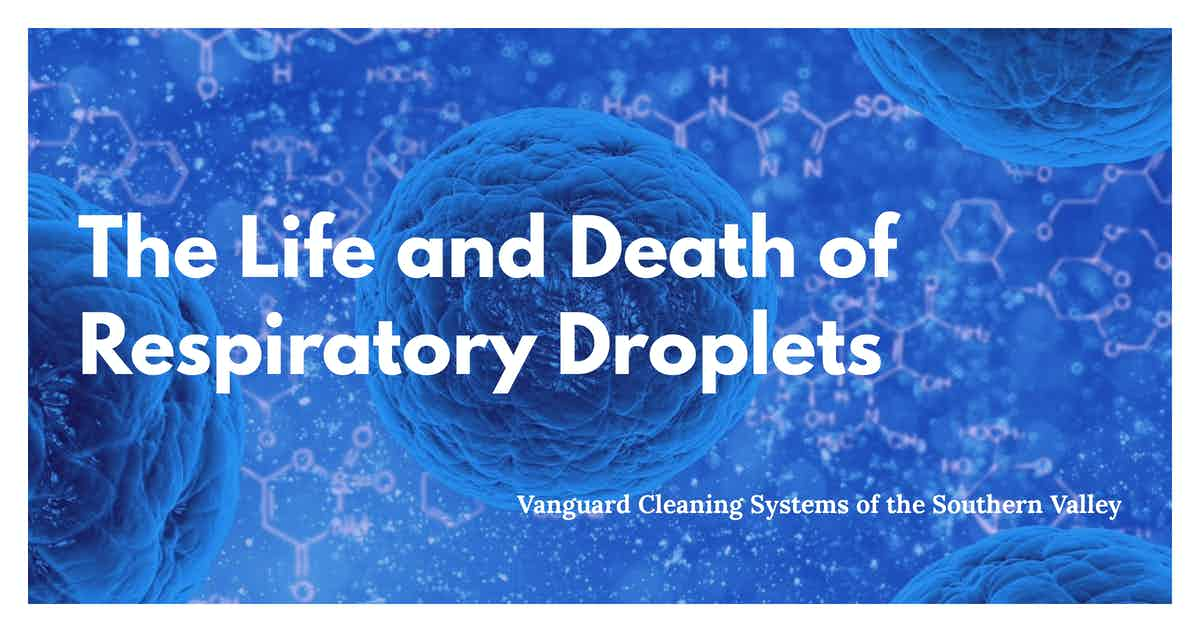Death from illness attributable to contact with contaminated respiratory droplets accounts for three of the top ten leading causes of death in the U.S.--COVID-19, Chronic Lower Respiratory Disease, Influenza, and Pneumonia.

Understanding Respiratory Droplets and the Routes of Infection
Contact with contaminated respiratory droplets primarily occurs in one of two ways:
- Dermal - Contact with a contaminated person--typically handshaking or other forms of skin-to-skin contact, or contact with a contaminated surface that is spread to the ears, eyes, nose, or mouth, and;
- Respiratory - Inhalation of contaminated airborne particles, including those previously resting on facility surfaces.
With the notable exception of SARS-CoV-2, most commonly transmitted respiratory illnesses, specifically influenza, are spread via dermal contact as opposed to respiratory.
A primary function of cleaning and sanitization services is to break the chain of infection by disrupting the various routes of transmission, e.g., high-contact surface (fomite) sanitization.
Until quite recently, a significant route of infection introduction into facilities--floors--was grossly overlooked by healthcare officials, including the US Centers for Disease Control and Prevention, who considered facility flooring non-critical in infection prevention.
A 2017 study commissioned by The Agency for Healthcare Research and Quality and the U.S. Department of Veterans Affairs forced the CDC to reconsider its position.
According to the studies findings, which examined the spread of pathogens and pathogenic bacteria from floors in a healthcare environment;
These results suggest that floors in hospital rooms could be an underappreciated source for dissemination of pathogens.
Moreover, the efficacy of current floor-cleaning and sanitization techniques should be reexamined, particularly with regard to eliminating C. difficile spores.
Other modes of transmission from floors also should be assessed, such as contamination of wheelchairs and wheeled equipment.
And transmission of other pathogens, such as gram-negative organisms and viruses, should be examined, the investigators said.
The infectious droplets were then spread further through the facility via:
- Airflow from the HVAC system or people walking by.
- Occupant dermal contact, or;
- Contact with equipment that touched the floor, then later by occupants.
The conclusion of the study found that;
- 18% of occupants had Methicillin-resistant Staphylococcus Aureus (MRSA) on their hands, and;
- 3% had Vancomycin-resistant Enterococci (VRE).
Droplet Lifecycle
Infectious droplets find their way onto facility floors and other surfaces when expelled from a contaminated host by:
- Breathing through the nose.
- Talking loudly.
- Sneezing, or;
- Coughing.
Once in the air, the droplet either falls directly to the ground or is aerosolized and travels briefly before falling to the ground or other surface, typically within six feet of the infected occupant.
Depending on the surface, environment, and type of contaminant, the virus or bacteria can survive and remain infectious for a few hours, up to several days.
Facility Floors are High-Contact Surfaces
Touchpoint sanitization services focus on reducing the detectable levels of infectious microbes on commonly touched surfaces to a point where transmission is unlikely.
To be effective, high-touch surfaces must be wiped down multiple times per day in accordance with facility occupancy, use, and the flow of foot traffic, i.e., the more people in the building and the more a surface is touched, the more often it should be sanitized.
Facility flooring is no exception and should be treated as a major germ hotspot that serves as a channel through the facility for the spread of disease.
Mopping high-traffic areas throughout the day will help halt the spread of contagion, but precautions must be observed:
- Regularly swap out the mop/mop head and water to prevent cross-contamination.
- Observe product dwell times.
- Ensure the product is accurately diluted.
- Make certain the floor is completely dry before allowing regular foot traffic to resume, and;
- Consider implementing automated floor scrubber technologies to reduce labor loads and improve cleaning outcomes.
References & Resources
Takeaway
Studies have shown that facility flooring serves as a major reservoir and route of transmission for respiratory illnesses.
As such, high-traffic floors should be treated as extremely high-contact surfaces and sanitized accordingly.
Manually operated and automated floor scrubbers can significantly improve cleaning outcomes but may be cost-prohibitive for many organizations.
Outsourcing is a proven method for onboarding highly in-demand cleaning and sanitization services and experience for a fraction of the price of maintaining a similar service in-house.
If you would like more information regarding the effectiveness of high-performance infection prevention and control measures, or if you would like to schedule a free, no-obligation on-site assessment of your facility's custodial needs, contact us today for a free quote!
In Bakersfield, CA, call (661) 437-3253
In Fresno, CA, call (559) 206-1059
In Valencia, CA, or Santa Clarita, CA, call (661) 437-3253
In Palmdale, CA or Lancaster, CA, call (661) 371-4756

